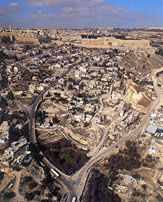
 |
|
|
|
|
|
|
|
|
|
|
|
|
|
| Home > History of Research > Tale of excavations > The City of David > Under British Rule |
 |
Excavations in the City of David Under British Rule
The conquest of the country from the Ottomans and the establishment of the British Mandate over Palestine brought about the 'Golden Age' of archaeological research in the country. Prof. John Garstang devoted himself to the foundation of a British School of Archaeology in Jerusalem, as well as of a governmental Department of Antiquities; once established in 1920, he served as director of both establishments for several years. Following a period of suspicion and even hostility toward archaeological research during the Ottoman regime, with archaeologists waiting for months for the Firman (permit) for their excavations to arrive from Constantinople, the British regime was a welcome change. Here was an authority only too appreciative of the historical momentum, in which the Holy Land was again in Christian hands. It readily welcomed archaeological research and endorsed archaeological activity. Out of a deep sense of scientific responsibility and perhaps also with a certain measure of religious awe, Garstang felt that Jerusalem and the City of David were part of world heritage and planned an international project of excavations on the 'City of David'. In August 1922, with the approval of the High Commissioner and the Archaeological Advisory Board, the Department of Antiquities approached academic institutions befitting such an esteemed project. Each participating party needed to procure the required budget (5000 Egyptian Pounds). Interestingly, only two expeditions could participate: a British and a French. The participation of the local Jewish expedition was indeed curtailed due to lack of funds: Though the Jewish Exploration Society had already been founded in 1913, discontinued and re-established with the creation of the British Mandate, funds were non-existent. A permit to excavate was issued to the directors of the Society I. Press and E. Ben-Yehuda but the Jewish Society did not meet the financial requirements and could not participate in the dig. Another archaeologist who expressed an interest to take part and a wish to dig near the Pool of Siloam was W.M. Flinders-Petrie, probably on behalf of the British School of Archaeology in Egypt. Part of this area was owned by the Rothschilds and caused delay in reply, due to which Petrie withdrew his request. R.A.S. Macalister and J.G. Duncan (1923-1925) R. Weill (second campaign, 1923-1924) J.W. Crowfoot and G.M. FitzGerald (1927-8) R.A.S. Macalister and J.G. Duncan (1923-1925) The Palestine Exploration Fund (PEF) was the most obvious participant in this international project due to its history of involvement in investigation of Jerusalem and the City of David in particular. And yet, it seems that at that particular time they found it difficult to raise the required budget of 5000 pounds and to recruit a reputed scholar for the mission. The PEF persuaded R.A.S.Macalister, who last worked in Palestine more than 20 years earlier, to represent them. The line of fortifications that Macalister and Duncan had revealed on the upper edge of the eastern slope descending to the Kidron Valley, the 'Jebusite Tower', and especially the stepped stone revetment in front of it, was their main discovery. These fortifications were much later examined by Kenyon and by Shiloh, and formed the most controversial element in the discussion on the character of the 13th-10th century BCE city. R. Weill (second campaign, 1923-1924) R.Weill, who was active here a decade earlier, represented the French. This time Weill failed to expose any significant remains. J.W. Crowfoot and G.M. FitzGerald (1927-8) Apparently the PEF had planned to maintain the momentum of excavations in Jerusalem recreated by the Macalister and Duncan excavations. Shortly a new expedition continued work, headed by J.W. Crowfoot who was nominated director of the British School of Archaeology in Jerusalem. This excavation aimed at the western side of the City of David and the Tyropoeon Valley that bounds it on the west. A massive fortification, most probably dating to the late Iron Age, was exposed below strata from the Byzantine and Early Roman periods. |